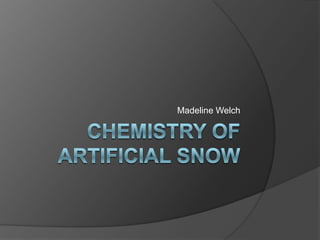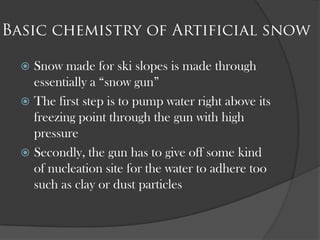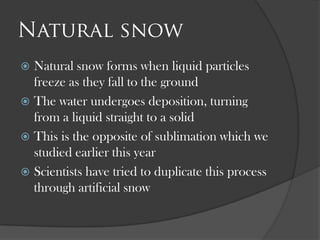Chemistry of snow
- 2. ï Artificial snow is used on ski slopes, movie sets and decorating. ï Artificial snow for ski slopes creates the same ski effect as natural snow does ï Brian Rohrig said that, âmore artificial snow falls on ski slopes than natural snow.â
- 3. ï Snow made for ski slopes is made through essentially a âsnow gunâ ï The first step is to pump water right above its freezing point through the gun with high pressure ï Secondly, the gun has to give off some kind of nucleation site for the water to adhere too such as clay or dust particles
- 4. ï Natural snow forms when liquid particles freeze as they fall to the ground ï The water undergoes deposition, turning from a liquid straight to a solid ï This is the opposite of sublimation which we studied earlier this year ï Scientists have tried to duplicate this process through artificial snow
- 5. ï The first and most important aspect of making this snow is having the correct humidity and the right temperature ï The process begins with the water right above its freezing point being shot out of the gun nozzle 20- 30 feet above the ground
- 6. ï While the water is being shot out, it is accompanied by compressed air ï This makes the water spread into small droplets and spreads them over a larger area ï The compressed air also helps lower the temperature because when gases expand the temperature lowers ï This happens because gases have weak attractive forces between their molecules and when the molecules are pushed farther apart they lose their kinetic energy
- 7. ï Depending on the temperature (15-20 degrees F), organic materials such as magnesium, calcium or clay particles can serve as nucleation sites ï If it isn't cold enough, inorganic materials such as silver iodide, soaps and detergents are used to help the snow form ï Once the water molecules adhere to the nucleation sites, the snow falls to the ground
- 8. ï A newer technology are machines that have nucleating agents in them that is produced with the water ï The agents are âdead, nonpathogenic bacteria that is cultured, freeze dried into pellets and finally sterilizedâ ï This process is becoming popular because it produces no pollution and is all natural
- 9. ï Formation of artificial snow enables ski resorts to have snow year round ï This directly affects the economy in those parts of the world ï The need for artificial snow to be made is the absence of deposition ï Snow isnt only important to ski slopes, but to movie makers to make scenes more life-like
- 10. ï Ritter, Steve. "Artificial Snow." The Newsmagazine of the Chemical World 19 Jan. 2004: 72. Chemical and Engineering News. Web. 10 Apr. 2013. <http://pubs.acs.org/cen/whatstuff/stuff/8203sno w.html>. ï Rohrig, Brian. "Artificial Snow Powder for the Slopes." ChemMatters Dec. 2000: 10-11. Print. ï American Chemical Society. "Artificial Snow Creates Winter All Year Round." ScienceDaily, 20 Jan. 2004. Web. 10 Apr. 2013.










